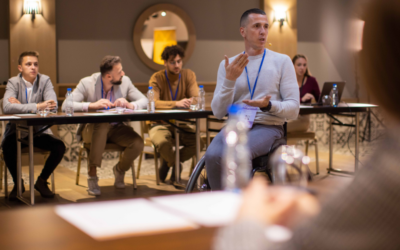You might think the hardest part of planning any event is choosing the location, but as it turns out, location isn’t everything – it’s only the beginning. Once you’ve nailed down the venue, it’s time to get to work filling the space with exhibits, signage, décor, and more to wow attendees and create an engaging and memorable experience. Before you stack your itineraries at the registration desk and welcome event attendees, you and your event organizer need to outfit your space with appropriate design elements.

Says Chelsea Litos, VP Account Management at AMI, “The design elements you choose will need to compliment your space, support your branding, create a mood, and provide a visually appealing atmosphere that creates a lasting impression for guests. With the right elements, you can deliver an immersive experience that begs to be shared.”
The last thing you want is for event attendees to be bored by your décor. Part of getting it right is staying true to your brand, while another factor revolves around understanding your audience. However, when you consider the elements of design, you have the opportunity to build a cohesive and compelling look from the ground up. Here are the essential design elements you and your convention planner should focus on when crafting your event.
Nail Down the Color Scheme with Your Convention Planner
Your color scheme may be drawn from an existing palette that coincides with your company branding, but you may also want to brand your event, and choosing the right color scheme can set an immediate and enduring tone for attendees. If, for example, you want to create a feeling of ethereal other-worldliness with a clean, bright palette, you might go with a tone-on-tone motif featuring shades of white, ecru, and eggshell. Or you might add touches of pastel hues to compliment the space.
If a more modern aesthetic is the order of the day, adding bright pops of candy-colored hues could create a feast for the eyes. Perhaps you want an edgy, futuristic vibe with dark, metallic tones or you’d rather create exotic appeal with rich, saturated jewel tones. The colors you and your convention planner choose will inform the mood of attendees from the moment they enter the space, so choose colors that elicit the right emotions.
Don’t Neglect Texture
Texture is an often-underused design element when it comes to events, but you should know that mixing textures can help to bolster your aesthetic and create a more attractive presentation overall. Appealing to tactile sensation with visual elements can enhance the experience for event attendees.
Layer on hard, soft, shiny, rough, rustic, and other textures to provide a landscape that is both visually stunning and that begs to be touched, catching the eye and the imagination. Adding a variety of textures can only help to make your event space more immersive. Don’t forget, you can also fake texture with pattern.
Visualize a Marriage of Lines
Your event space itself will have built-in lines that are horizontal and vertical, at the very least, although you might also find yourself dealing with diagonal lines, as well as those that are dynamic (curved, for example). Whether you and your event organizer decide to mimic existing lines in your design or work against them, it’s important to be aware of the lines in your space so you can make a conscious decision about how you install the lines of your design, from backdrops and rugs to furniture and other décor.
See How Shapes Fit into Your Space
The shapes you choose and the way you arrange them can have an impact on how people approach your space. For example, if you add a lounge space with groupings of plush couches and chairs, you’ll invite attendees to sit and socialize, perhaps having extensive conversations. If you only add cocktail tables near a bar, you may still spur conversation, but guests won’t necessarily be inclined to relax or stay long – they may be more likely to drift through and meet more people briefly.
Adjust the Size of Elements
You and your convention planner can create focal points or emphasize elements of design by simply adjusting the size. Take a page from famed sculpture artist Claes Oldenburg by blowing up object to enormous size – see popular pieces like Lipstick (Ascending), Clothespin, and Binoculars Building for examples.
Add Lighting with the Help of Your Event Organizer
Lighting may not technically be an element of design, but how you and your event organizer use it to highlight your space can contribute to or detract from your overall design, so it bears consideration. It can influence mood, draw attention, and add unexpected flair to your design, helping to boost visual appeal and make your event a success.



